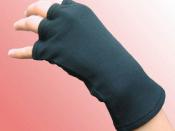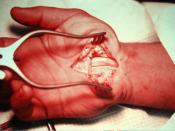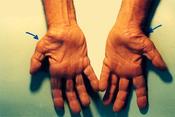Running head: ULTRASOUND AND CARPAL TUNNEL SYNDROME The Effects of Ultrasonic Therapy on Carpal Tunnel Syndrome Introduction Ultrasound Therapy In therapy, many different heating agents are used to treat patients. Heat enhances joint mobility, reduces pain, and increases blood flow to an area. To receive the optimal benefits from heat, the patient's tissue temperature must be raised to 105 to 113 degrees. Therapists must be cautious of any temperatures that exceed 113 degrees. Contraindications to using heat are sensory deficits, acute diagnoses, elderly and pediatric populations, and patients suffering from vascular impairment (Pedretti & Early, 2001).
One of the most prevalent heating agents is therapeutic ultrasound. According to Pedretti and Early (2001), ultrasound is a technique that is utilized by penetrating the deep muscles through sound waves. A transducer generates these sound waves, when the waves reach the tissues, they vibrate the molecules causing friction, allowing for the production of heat.
The therapist gently massages the patient's limb in a rhythmic motion with the transducer, allowing the sound waves to reach the deep muscles. To promote this deep penetration a gel is applied to the limb in which the transducer glides across when massaging. The MHz setting dictates the frequency of the sound waves. The W/cm2 is the intensity or the depth to which the heat can reach. For example, at 1 W/cm2, heat can travel up to 5cm in depth.
Ultrasound can also be used as a nonthermal agent in therapy. The sound waves can penetrate different anti-inflammatory medications into the skin without the use of heat. This technique is typically referred to as phonophoresis.
Ultrasound can be used on diagnoses such as carpal tunnel syndrome, lateral epicondylitis, and calcific shoulder. Therapists use ultrasound to treat "joint contractures, scarring with associated adhesions and muscle spasms"ÃÂ (Pedretti & Early, 2001,


